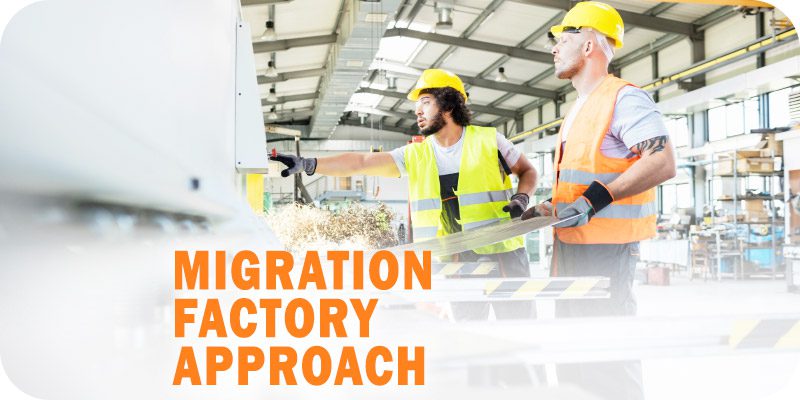Migration Factory Approach: Introduction and Keys to Consider


This is part of Solutions Review’s Premium Content Series, a collection of contributed columns written by industry experts in maturing software categories. In this submission, Syniti CTO and EVP of Growth & Innovation Rex Ahlstrom offers an outline of the migration factory approach, with tips on how to decide if it’s right for your organization.
 With the continued trend of large-scale digital transformation, mergers, acquisitions, divestitures, and the ongoing push to move to the cloud, more organizations are looking to tackle data migration projects. But as they approach these migrations, many are still grappling with a mix of legacy systems, on-premises and hybrid cloud deployments, siloed information, and dark data.
With the continued trend of large-scale digital transformation, mergers, acquisitions, divestitures, and the ongoing push to move to the cloud, more organizations are looking to tackle data migration projects. But as they approach these migrations, many are still grappling with a mix of legacy systems, on-premises and hybrid cloud deployments, siloed information, and dark data.
For a large organization with massive amounts of data and systems that need to be consolidated or migrated to new applications, the idea of a repeatable template or process can be very appealing. This is also true for organizations facing multiple merger, acquisition, or divestiture (MA&D) events. The challenges faced by these organizations give rise to the concept of migration factories. Essentially, this entails creating a common migration pattern that a company can use to harmonize and consolidate data assets to meet the business process requirements and operating model of the company.
How do you know if this is the right approach for your organization? There are a few factors to consider.
Migration Factory Approach
What is a Migration Factory?
Let’s say you’re looking to migrate data from several standard sources that are fairly well-known. You don’t want to have to recreate the wheel or start from scratch each time; you don’t want to have to treat every migration like a snowflake, because it gets too expensive, and it doesn’t build off what you’ve learned in prior migrations.
A migration factory is all about creating repeatable templates and rules – so each migration can follow a standard pattern, with as little customization as possible. With this model, you’re building a working team that represents a skilled set of resources and uses a common methodology and software tools. When this team is faced with simple or complex migrations, or projects with tight timelines, they are better prepared to deliver success.
Another critical element of a migration factory is the ability to engage both business and technical knowledge workers throughout the process. Data ownership cannot reside purely with the technical team but often, the tools available only address the needs of technically trained resources. Data ownership and team structures for a migration factory need to be a blend of technical, business process, and business unit owners.
Another form of migration factory is when a service provider – typically a system integrator or a specialist services company – wants to build an outsourced service for rapid conversion of specific source and target systems. For example, the need to move from a legacy on-prem ERP system to the vendor’s latest cloud-based ERP offering. The customer benefits because they get converted faster – and more cost-efficiently – and ERP software vendors benefit because it simplifies moving customers to their latest software offerings. Bottom line is that the outcome is more predictable from both a time and cost perspective.
Is a Migration Factory Approach Right for You?
Migration factories are called factories because they work for repeat, rote types of migrations –situations where you have a common target system or source/target systems. So, if there is little in common between migration events from a source/target perspective, a migration factory may still be a good choice, but the level of automation achieved will be limited to common methodology and tools. The highest degree of automation is achieved when you have a specific template for the systems involved and the data models required to support proper business process execution.
So, how do you determine the right approach? Start by looking at specific processes, such as mergers, acquisitions, and divestiture (MA&D). If your company is going to go through multiple acquisitions, and you realize your business is going to be continually changing through MA&D, establishing a migration factory could be very effective. If you are facing large-scale system consolidation, a migration factory may be a great choice for shortening what will certainly be a multi-year rollout. If this is something you plan to outsource or deliver in combination with your global system integrator, work together to determine operational structures, responsibilities, and accountability as part of the migration factory process.
Core to this approach is the tool and methodology standardization – having pre-built content or templates and project plans, rules, or mappings. Even if you’re dealing with various systems, the more of this standardization you have, then the more you’re going to be able to automate via a migration factory.
Building the Right Migration Factory for your Needs
The methodology is critical. If there is no common methodology right away, just because you use a common set of tools, even a common set of templates, you’re not going to achieve a high degree of repeatability or automation. A second important factor is the tools you use. If they don’t embed that methodology in terms of how the tool is built, and you’re reliant on the person to implement the methodology but the tools don’t bound you by that methodology, there’s a risk that it won’t be followed. And you will need experts who can execute this work.
You’ll also need to implement continuous improvement to get the process to a place where it’s operating like a well-oiled machine. This is an agile process; every subsequent migration you do using a migration factory approach should improve. You should focus on improving the content, the process, and the standards you’re using to deliver the result. So, the more migrations you do, the better your process will become, and you’re refining your process so that it does become a well-oiled machine.
Business stakeholders also need to be part of the change management process. If there are changes to core business processes, or there are new requirements being driven by a change in business goals, then the business must be a key stakeholder in approving changes to the migration factory. Understanding how the business is directly impacted by data ensures the “factory” can adapt quickly to change.
Making Migration Better
If you’re going to be conducting a number of migrations that follow a similar pattern, it can save major time and resources to have a locked-and-loaded, templated process laid out. That’s the benefit of a migration factory: a collection of teams, tools, and processes that work together to streamline migrations in a systematic way. If you’re currently involved in or foresee multiple similar migrations in your organization’s future, a migration factory approach is worth considering. Use the best practices noted above to create an approach that saves your company time and money while reducing headaches for the IT team.





















